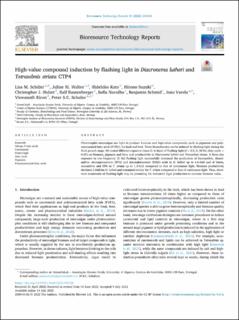High-value compound induction by flashing light in Diacronema lutheri and Tetraselmis striata CTP4
Schüler, Lisa M.; Walter, Juline; Kato, Hidehiko; Suzuki, Hirono; Hulatt, Christopher Jonathan; Rautenberger, Ralf; Navalho, Sofia; Schmid, Benjamin; Varela, Joao; Viswanath, Kiron; Schulze, Peter Simon Claus
Peer reviewed, Journal article
Published version
Permanent lenke
https://hdl.handle.net/11250/3023887Utgivelsesdato
2022Metadata
Vis full innførselSamlinger
Originalversjon
Schüler, L. M., Walter, J., Kato, H., Suzuki, H., Hulatt, C. J., Rautenberger, R., Navalho, S., Schmid, B., Varela, J., Viswanath, K. & Schulze, P. S. C. (2022) High-value compound induction by flashing light in Diacronema lutheri and Tetraselmis striata CTP4. Bioresource Technology Reports, 19. doi: 10.1016/j.biteb.2022.101158Sammendrag
Phototrophic microalgae use light to produce biomass and high-value compounds, such as pigments and polyunsaturated fatty acids (PUFA), for food and feed. These biomolecules can be induced by flashing light during the final growth stage. We tested different exposure times (1–6 days) of flashing light (f = 0.5, 5, 50 Hz; duty cycle = 0.05) on biomass, pigment and fatty acid productivity in Diacronema lutheri and Tetraselmis striata. A three-day exposure to low-frequency (5 Hz) flashing light successfully increased the production of fucoxanthin, diatoxanthin, eicosapentaenoic (EPA) and docosahexaenoic (DHA) acids in D. lutheri up to 4.6-fold and of lutein, zeaxanthin and EPA in T. striata up to 1.3-fold compared to that of continuous light. Biomass productivity declined 2-fold for D. lutheri and remained similar for T. striata compared to that of continuous light. Thus, short-term treatments of flashing light may be promising for industrial algal production to increase biomass value.

